Press release 2021-09-24 at 13:45
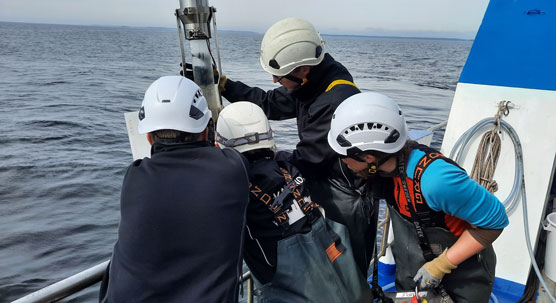
Monitoring the coastal waters of the Gulf of Finland. © Photo: Seppo Knuuttila
Monitoring cruises undertaken in August by the Finnish Environment Institute show that the Gulf of Finland has recovered from the deterioration caused indirectly by salt pulses in the Baltic Sea in the mid-2010s. Weather-regulated flows between the Gulf of Finland and the main basin of the Baltic Sea cause fluctuations in the state of the Gulf, which makes it difficult to discern the impact of emission reductions. In deep-water regions of the Bothnian Sea, oxygen levels appear to continue to deteriorate.
Positive development in the coastal waters of the Gulf of Finland, record-high nutrient concentrations in the central part
Between 2014 and 2016, several pulses of salty water flowed into the Baltic Sea from the North Sea. The detrimental effects of salty, oxygen-deficient and nutrient-rich water displaced by the salt pulses were evident in the oxygen situation in the Gulf of Finland in August 2019. In 2021, oxygen levels in the open sea areas of the Gulf of Finland were worse than in summer 2020, but still better than in 2019 (Figure: Oxygen, August 2019, 2020 and 2021). Similarly, phosphorus concentrations on the seafloor were higher than in 2020 but mostly lower than in 2019 (Figure: Phosphate phosphorus, August 2019, 2020 and 2021).
Concentrations of biologically available phosphorus and nitrogen measured in the central part of the Gulf of Finland in August were the highest in the 50 years of measurements. The high concentrations are likely explained by water from the main basin of the Baltic Sea trapped in the Gulf, to which nutrients released from the seafloor have accumulated.
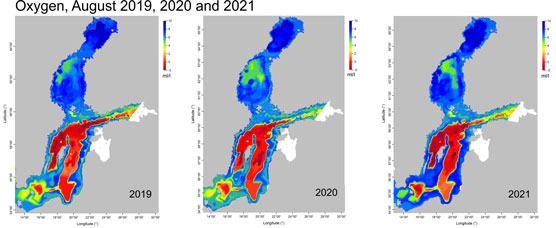
Oxygen situation near the seabed in the open sea from the southern Baltic Sea to the Bay of Bothnia in August 2019, 2020 and 2021. © SYKE Data: SYKE and SMHI
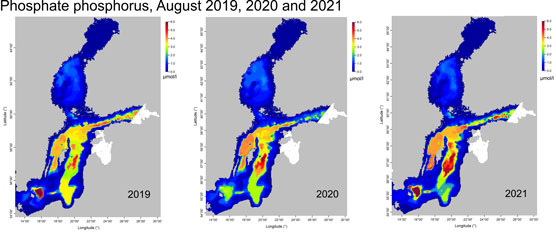
In 2021, phosphorus concentrations on the seafloor of the Gulf of Finland were higher than in 2020 but mostly lower than in 2019. © Data: SYKE and SMHI
In the coastal waters of the Gulf of Finland, the state of the seafloor was among the best seen during the 20 years of measurements. At the majority of observation stations, surface sediment was oxygenated and benthic animals were present (Figure: Occurrence of benthic fauna in the Gulf of Finland in 2001–2021). The state of the seafloor has improved in the outer archipelago and near the open sea. In contrast, the state of small coastal depressions in the inland archipelago with low water turnover has not improved during the monitoring period.
Phosphorus load into the Gulf of Finland has decreased by about 60 percent since 2000. Despite this, concentrations of chlorophyll a in the eastern Gulf of Finland, indicating the amount of algae, are unchanged from the early 1990s (Figure: Chlorophyll a, Huovari, July–August 1981–2021). At the same time as load has decreased, the halocline of the main basin of the Baltic Sea has increased in elevation, and large amounts of phosphorus have flowed into the Gulf of Finland with deep water from the main basin. The decrease in phosphorus load may partly explain the reversal of eutrophication in the eastern Gulf of Finland, where, in fact, the effects of the large emission reductions in Russia should be first observed.
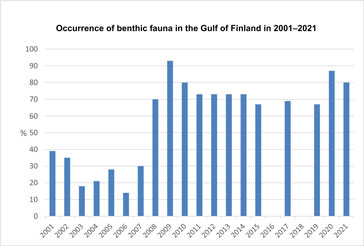
In the coastal waters of the Gulf of Finland, the state of the seafloor was among the best seen during the 20 years of measurements. Benthic animals were present at the majority of observation stations. © SYKE

Measurements performed at the intensive monitoring station in Huovari island indicate that concentrations of chlorophyll a in the eastern Gulf of Finland are unchanged from the early 1990s. © Data: ELY Centre for Southwest Finland and SYKE © SYKE
A phosphorus deposit is building in the deep water of the Baltic Sea main basin
Oxygen levels in the main basin of the Baltic Sea and the Bothnian Sea were quite similar this summer to that in the previous summers 2019 and 2020 (Figure: Oxygen profile, August 2019, 2020 and 2021). In the main basin, the water layer below a depth of 70 to 80 metres is anoxic.
In the Bothnian Sea, the oxygen situation has deteriorated since 2000. Oxygen is still found in deep waters of the Bothnian Sea, but the declining trend in oxygen levels is worrying, especially as phosphorus levels have risen and large-scale blue-green algal blooms have become more common.
Oxygen concentrations in the Åland Sea basin were lower than in previous years. (Figure: Oxygen profile, August 2019, 2020 and 2021). In the Archipelago Sea, oxygen levels in water near the sea floor were close to long-term averages with the exception of southern parts of the sea, where the levels were below long-term averages. The highest concentrations of nutrients in the Archipelago Sea were also measured in the deep waters of the southern part. Lowered oxygen levels and increased nutrient concentrations are likely due to water from the main basin.
Phosphorus concentrations in the deep waters of the Baltic Sea main basin have continued to increase (Figure: Phosphate phosphorus, August 2019, 2020 and 2021). Lack of oxygen in these regions prevents phosphorus from being bound in the bottom sediment.

Oxygen profile from the southern Baltic Sea to the Bay of Bothnia in August 2019, 2020 and 2021. The declining trend in oxygen levels in the Bothnian Sea is worrying. © SYKE Data: SYKE and SMHI
Monitoring data crucial for assessing the sea’s condition
Research vessel Aranda makes four monitoring cruises on the state of the Baltic Sea annually. In addition, a smaller vessel is used to monitor the coastal waters of the Gulf of Finland in August. The cruises are part of the Finnish Environment Institute’s and the Finnish Meteorological Institute's monitoring of long-term changes in the state of the Baltic Sea as part of the Monitoring Program for Finland’s Marine Strategy and the joint HELCOM Monitoring Programme.
Monitoring cruises collect data on the physics, chemistry and biology of the Baltic Sea and harmful substances from the bottom sediment to the surface. This data makes it possible to assess the sea’s oxygen levels, eutrophication, and potential changes in plankton and benthic fauna, among other uses. The observations are based on cruises in July and August by research vessel Aranda, the coastal monitoring vessel and the Swedish Meteorological and Hydrological Institute’s (SMHI) research vessel Svea.
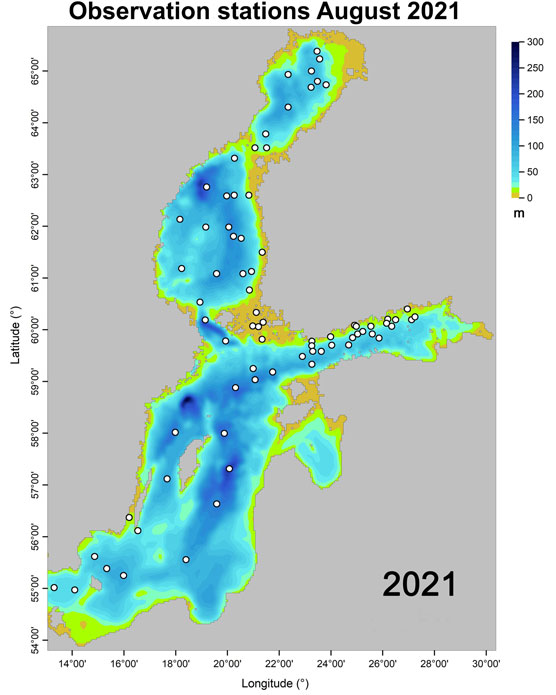
© SYKE
Further information:
- Gulf of Finland: Maiju Lehtiniemi, Research Professor, Leader of the Aranda expedition, Finnish Environment Institute, tel. +358 295 251 356, firstname.lastname@syke.fi
- Coastal monitoring of the Gulf of Finland: Seppo Knuuttila, Senior Research Scientist, Finnish Environment Institute, tel. +358 295 251 286, firstname.lastname@syke.fi
- Baltic Proper and Gulf of Bothnia: Pekka Kotilainen, Senior Researcher, Leader of the Aranda expedition, Finnish Environment Institute, tel. +358 295 251 317, firstname.lastname@syke.fi
- Baltic Sea internal nutrient flows: Jouni Lehtoranta, Senior Research Scientist, Finnish Environment Institute, tel. +358 295 251 363, firstname.lastname@syke.fi
-
Eija Järvinen, Communications Specialist, Finnish Environment Institute, tel. +358 295 251 242, firstname.lastname@syke.fi
Pictures for media use: